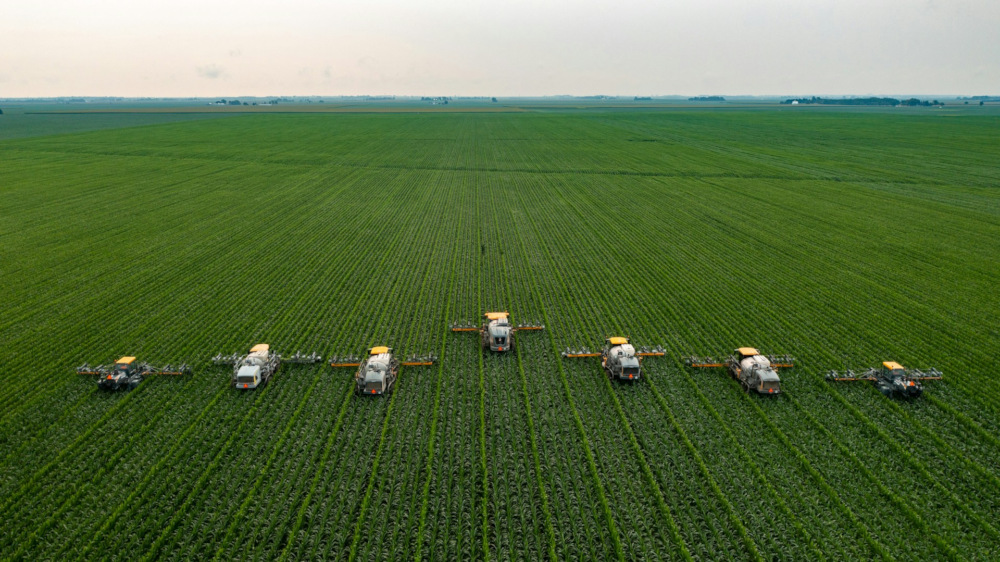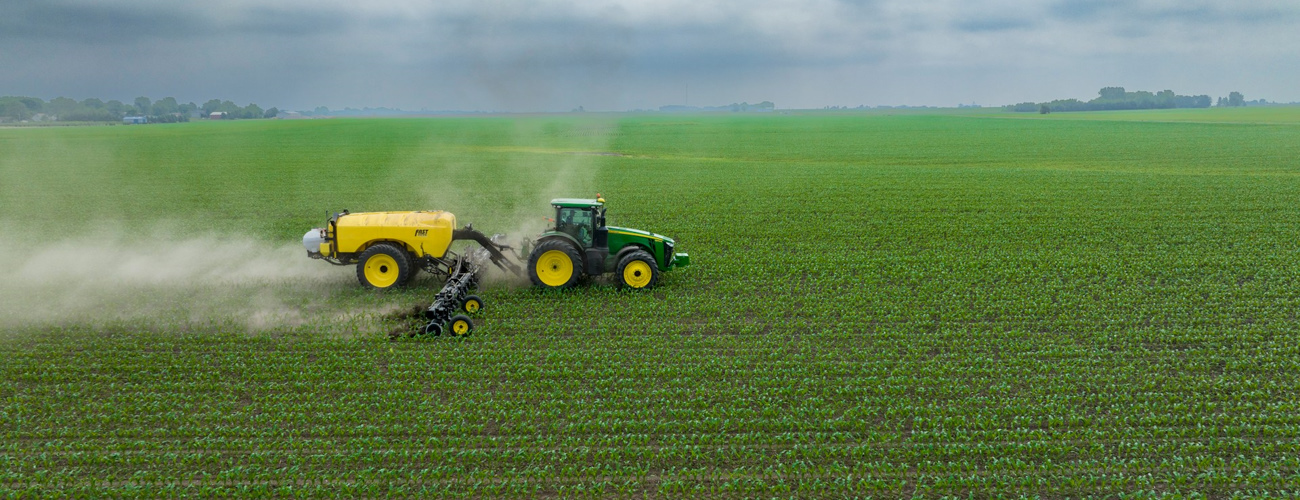Agriculture Software Development
Modern agriculture relies on timely decisions backed by reliable data. The challenge is that farm operations often depend on scattered systems, manual reporting, and tools that don’t talk to each other. This creates delays, limits transparency across the supply chain, and makes future planning slow and reactive. Agriculture software development addresses these gaps by connecting equipment, field activity, crop performance, and financial workflows into one actionable environment.

Our Offerings
Farm Management Software Development
We build farm management platforms that centralize operational data—crop schedules, equipment activity, soil observations, labor assignments, and financial records—into one interface. These systems support planning from early planting through harvest and give managers a transparent view of what’s happening in each field. They can also connect with existing tools such as telematics feeds, climate data sources, irrigation controllers, or ERP platforms. This helps reduce manual reporting and brings more structure to daily operations.
IoT & Sensor Integration
Agriculture relies heavily on knowing what’s happening in the field at the right moment. We integrate data collected from sensors, drones, and farm machinery—soil temperature, moisture, nutrient levels, equipment status—into purpose-built applications. These systems help operators make informed decisions on irrigation timing, fertilization, and equipment maintenance. For example, alerts can signal irrigation adjustments when soil moisture readings fall outside a defined range, helping reduce water waste and protect yield quality.
Precision Agriculture & Analytics Tools
We develop analytics platforms that convert raw agronomic and environmental data into clear forecasts and recommendations. These tools support decisions like zoned fertilization, planting density, or ideal treatment timing. By combining spatial mapping, yield models, and historical performance, organizations can identify underperforming fields, compare outcomes season to season, and run predictable production plans. Results are typically presented through visual dashboards that focus on practical day-to-day use.
Supply Chain & Logistics Systems
Agriculture supply chains are sensitive to time and product quality. We build logistics systems that coordinate transportation, storage, and order management across the agricultural lifecycle. These platforms can track perishable inventory, automate scheduling, manage carriers, and provide visibility from farm to distribution center. Integrating this with production planning helps reduce spoilage and improve forecasting accuracy for both outbound and inbound flows.
ERP Integrations & Agribusiness Back-Office Software
Many organizations still track critical functions like procurement, warehouse operations, and accounting across separate systems or spreadsheets. We develop and integrate software that aligns field activity with back-office functions, helping teams track budgets, reconcile contracts, and manage vendor relationships. This reduces administrative friction and improves the accuracy of operational reporting. When needed, integrations with major ERPs support financial and compliance processes without re-creating existing workflows.
Field Workforce & Equipment Management Tools
Agriculture operations rely on distributed workforces and machinery. We create systems that help dispatch workers, record task completion, monitor equipment usage, and forecast maintenance needs. Teams can assign jobs, record field observations, and track machine health from mobile devices. Insights like fuel consumption, downtime patterns, or operator performance help organizations maintain asset availability and plan investments more carefully.
How We Bring Value To Your Business
Agriculture companies gain practical tools for managing operations, aligning teams, and making decisions based on consistent data. The focus is on outcomes that affect daily productivity—from resource use to delivery schedules—rather than abstract promises.
1
Improve visibility across operations
Centralized systems allow managers to track field activity, resource usage, and production progress without digging through spreadsheets or siloed applications. This reduces delays and helps teams act on the same information at the right time.
2
Reduce operational overhead
Manual reporting, disconnected tools, and repetitive data entry create unnecessary work. Custom agriculture software replaces fragmented processes with automated workflows that help teams focus on production, logistics, and planning rather than administrative tasks.
3
Strengthen production planning
Historical performance, weather data, and soil metrics can be analyzed to guide next-season crop planning. This gives leaders more confidence when making decisions about seed selection, planting windows, or equipment utilization.
4
Control supply-chain risks
Real-time monitoring of transport, storage, and downstream distribution helps reduce spoilage and avoid logistic bottlenecks. Teams can respond faster to schedule disruptions and maintain stable delivery commitments.
5
Support cost-efficient resource allocation
Software helps track fertilizer, water usage, machinery hours, and labor distribution. With better visibility, managers can reduce waste and assign resources based on need rather than estimates.
6
Simplify compliance and record-keeping
Custom tools capture documentation around land use, environmental standards, and production reporting. Storing this information digitally lowers the burden of audits and allows teams to retrieve accurate records quickly.
Challenges We Commonly Solve
Agriculture organizations operate across shifting environmental, logistical, and market conditions. The main barrier is not a lack of data, but the difficulty of organizing workflows, integrating systems, and acting on information at scale.
Start a conversation about your project.
Why Choose WiserBrand
Agriculture companies often need more than a development vendor. They need a partner who can work with existing systems, adapt to established operations, and guide technical decisions without disrupting ongoing production.
1
Experience aligning software with real operations
We focus on how work is done today before proposing new tools. This reduces surprises during delivery and helps teams adopt technology with fewer workflow changes. Our software projects prioritize clarity around data, roles, and decision points so operations leaders can move at a manageable pace.
2
Ability to integrate with existing tools and data
Agriculture organizations rarely begin with a clean slate. We work with ERPs, telematics feeds, CRMs, and legacy reporting tools to create a unified environment without discarding what already works. This approach supports faster adoption and reduces the cost of replacing systems.
3
Transparent, collaborative delivery
We involve stakeholders throughout design and development. The goal is to give leaders predictable progress and clear input opportunities. Communication stays practical—focused on timelines, scope, and outcomes instead of process jargon or abstract benefits.
Cooperation Models
Each agriculture organization approaches technology differently. Some need ongoing development support, while others prefer a team for a specific project. We offer flexible collaboration structures that align with your pace and internal capabilities.
This model is suitable when you already have a defined scope or roadmap. We work with your team to plan delivery, handle development, and guide implementation. Project-based work allows IT and operations leaders to budget confidently and move forward without expanding internal staff.
A dedicated team works as an extension of your internal group. This model gives you stable capacity across engineering, QA, data, and product roles. It works well for organizations maintaining long-term software programs such as crop-management platforms, logistics systems, or analytics tools. The team collaborates closely with your internal stakeholders and adapts as priorities shift.
Some organizations want external expertise but keep key development activities in-house. In a hybrid setup, our specialists work alongside your team to support planning, core features, integrations, or legacy modernization. This structure offers flexibility and helps build internal knowledge while maintaining consistent delivery.
Our Experts Team Up With Major Players
Partnering with forward-thinking companies, we deliver digital solutions that empower businesses to reach new heights.
Our Approach
We work in structured phases that keep development predictable and aligned with real operational needs. The goal is to build software that fits current agriculture workflows while leaving room for future growth.
Discovery & Context
We learn how your operations function today—field activity, planning cycles, existing tools, and data sources. This helps us understand what works well and what creates bottlenecks before proposing new software.
Architecture & Planning
Based on your goals and constraints, we map out the core features, integrations, and data structures. This gives both sides a shared view of scope, technical direction, timelines, and dependencies.
Iterative Development
Development happens in manageable increments so your team can review progress and provide feedback early. This helps confirm that the system aligns with your processes before expanding functionality.
Validation & Field Testing
We validate that the software functions as expected in real environments. Field testing helps uncover adjustments needed to support actual usage—device conditions, connectivity limitations, or different operator roles.
Deployment & Ongoing Support
Once the system is ready for production, we support rollout, onboarding, and ongoing product improvements. Teams can expand capabilities gradually, such as adding IoT data pipelines, analytics layers, or additional integrations.
Case Studies
Our case studies highlight the outcomes we’ve delivered and the approaches that made them possible.
Agriculture Software Development FAQ
Farming cooperatives, growers, processors, distributors, and agribusiness service providers often see value in unified systems that support planning, resource management, and logistics.
Yes. Many platforms integrate with telematics, sensor networks, drones, and ERP systems to collect and exchange data without changing field equipment.
Timelines vary by scope. Most projects fall between a few months for focused platforms and longer for multi-system implementations. Early scoping helps define a practical schedule.
Common sources include IoT devices, weather feeds, satellite imaging, drones, GPS equipment, and internal business systems such as procurement or inventory tools.
Yes. We assist with system updates, improvements, and new features as operational needs evolve.























